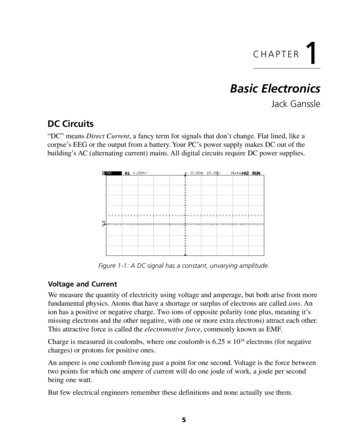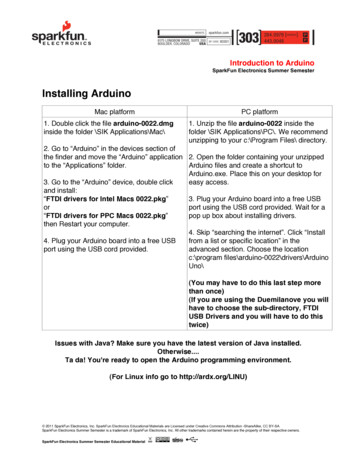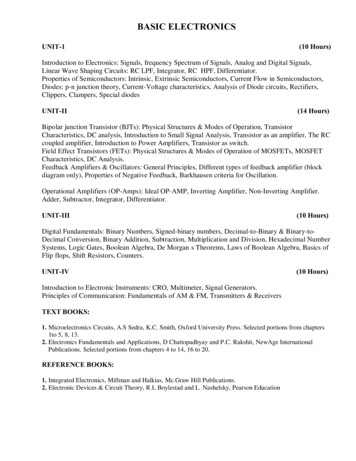
Transcription
CHAPTER1Basic ElectronicsJack GanssleDC Circuits“DC” means Direct Current, a fancy term for signals that don’t change. Flat lined, like acorpse’s EEG or the output from a battery. Your PC’s power supply makes DC out of thebuilding’s AC (alternating current) mains. All digital circuits require DC power supplies.Figure 1-1: A DC signal has a constant, unvarying amplitude.Voltage and CurrentWe measure the quantity of electricity using voltage and amperage, but both arise from morefundamental physics. Atoms that have a shortage or surplus of electrons are called ions. Anion has a positive or negative charge. Two ions of opposite polarity (one plus, meaning it’smissing electrons and the other negative, with one or more extra electrons) attract each other.This attractive force is called the electromotive force, commonly known as EMF.Charge is measured in coulombs, where one coulomb is 6.25 1018 electrons (for negativecharges) or protons for positive ones.An ampere is one coulomb flowing past a point for one second. Voltage is the force betweentwo points for which one ampere of current will do one joule of work, a joule per secondbeing one watt.But few electrical engineers remember these definitions and none actually use them.5
Chapter 1Figure 1-2: A VOM, even an old-fashioned analog model like this 10Radio Shack model, measures DC voltage as well or better than a scope.An old but still apt analogy uses water flow through a pipe: current would be the amount ofwater flowing through a pipe per unit time, while voltage is the pressure of the water.The unit of current is the ampere (amp), though in computers an amp is an awful lot ofcurrent. Most digital and analog circuits require much less. Here are the most commonnomenclatures:NameAbbreviation# of ampsWhere likely foundampA1Power supplies. Very high performanceprocessors may draw many tens of amps.milliampmA.001 ampLogic circuits, processors (tens or hundreds ofmA), generic analog circuits.microampµA10-6 ampLow power logic, low power analog, batterybacked RAM.picoamppA10-12 ampVery sensitive analog inputs.femtoampfA10-15 ampThe cutting edge of low power analogmeasurements.Most embedded systems have a far less extreme range of voltages. Typical logic andmicroprocessor power supplies range from a volt or two to five volts. Analog power suppliesrarely exceed plus and minus 15 volts. Some analog signals from sensors might go down tothe millivolt (.001 volt) range. Radio receivers can detect microvolt-level signals, but do thisusing quite sophisticated noise-rejection techniques.6
Basic ElectronicsResistorsAs electrons travel through wires, components, or accidentally through a poor soul’s body,they encounter resistance, which is the tendency of the conductor to limit electron flow. Avacuum is a perfect resistor: no current flows through it. Air’s pretty close, but since water isa decent conductor, humidity does allow some electricity to flow in air.Superconductors are the only materials with zero resistance, a feat achieved through themagic of quantum mechanics at extremely low temperatures, on the order of that of liquidnitrogen and colder. Everything else exhibits some resistance, even the very best wires. Feelthe power cord of your 1500 watt ceramic heater—it’s warm, indicating some power is lost inthe cord due to the wire’s resistance.We measure resistance in ohms; the more ohms, the poorer the conductor. The Greek capitalomega (Ω) is the symbol denoting ohms.Resistance, voltage, and amperage are all related by the most important of all formulas inelectrical engineering. Ohm’s Law states:E I Rwhere E is voltage in volts, I is current in amps, and R is resistance in ohms. (EEs like to use“E” for volts as it indicates electromotive force).What does this mean in practice? Feed one amp of current through a one-ohm load and therewill be one volt developed across the load. Double the voltage and, if resistance stays thesame, the current doubles.Though all electronic components have resistance, a resistor is a device specifically made toreduce conductivity. We use them everywhere. The volume control on a stereo (at least, thenon-digital ones) is a resistor whose value changes as you rotate the knob; more resistancereduces the signal and hence the speaker output.Figure 1-3: The squiggly thing on the left is the standard symbol usedby engineers to denote a resistor on their schematics. On the right isthe symbol used by engineers in the United Kingdom. As Churchill said,we are two peoples divided by a common language.7
Chapter 1NameAbbreviationohmsWhere likely foundmilliohmmΩ.001 ohmResistance of wires and other goodconductors.ohmΩ1 ohmPower supplies may have big droppingresistors in the few to tens of ohms range.hundredsof ohmsIn embedded systems it’s common to findresistors in the few hundred ohm rangeused to terminate high speed signals.kiloohmk Ω or just k1000 ohmsResistors from a half-k to a hundred ormore k are found all over every sort ofelectronic device. “Pullups” are typicallya few k to tens of k.megaohmMΩ106 ohmsLow signal-level analog circuits.108 ohmsGeiger counters and other extremelysensitive apps; rarely seen as resistors ofthis size are close to the resistance of air.hundredsof M ΩTable 1-1: Range of values for real-world resistors.What happens when you connect resistors together? For resistors in series, the total effectiveresistance is the sum of the values:Reff R1 R2For two resistors in parallel, the effective resistance is:Reff (Thus, two identical resistors in parallel are effectively half the resistance of either of them:two 1ks is 500 ohms. Now add a third: that’s essentially a 500-ohm resistor in parallel with a1k, for an effective total of 333 ohms).The general formula for more than two resistors in parallel is:Reff 8
Basic ElectronicsFigure 1-4: The three series resistors on the left areequivalent to a single 3000-ohm part. The threeparalleled on the right work out to one 333-ohm device.Manufacturers use color codes to denote the value of a particular resistor. While at first thismay seem unnecessarily arcane, in practice it makes quite a bit of sense. Regardless oforientation, no matter how it is installed on a circuit board, the part’s color bands are alwaysvisible.Figure 1-5: This black and white photo masks the resistor’s color bands.However, we read them from left to right, the first two designatingthe integer part of the value, the third band giving the multiplier.A fourth gold (5%) or silver (10%) band indicates the part’s tolerance.9
Chapter 1Color iteGold (3rd band)Silver (3rd 0001,000,000not usednot usednot used 10 100Table 1-2: The resistor color code. Various mnemonic devices designed to help oneremember these are no longer politically correct; one acceptable but less memorablealternative is Big Brown Rabbits Often Yield Great Big Vocal Groans When Gingerly Slapped.The first two bands, reading from the left, give the integer part of the resistor’s value. Thethird is the multiplier. Read the first two band’s numerical values and multiply by the scaledesignated by the third band. For instance: brown black red 1 (brown) 0 (black) times 100(red), or 1000 ohms, more commonly referred to as 1k. The following table has eredyellowredgreenblackgoldred12 x 100022 x 10033 x 10,00056 x 10056 x 100,00022 x 110 1068 x 330k5.6k5.6M2216.8kTable 1-3: Examples showing how to read color bands and compute resistance.Resistors come in standard values. Novice designers specify parts that do not exist; theexperienced engineer knows that, for instance, there’s no such thing as a 1.9k resistor.Engineering is a very practical art; one important trait of the good designer is using standardand easily available parts.10
Basic ElectronicsCircuitsElectricity always flows in a loop. A battery left disconnected discharges only very slowlysince there’s no loop, no connection of any sort (other than the non-zero resistance of humidair) between the two terminals. To make a lamp light, connect one lead to each batteryterminal; electrons can now run in a loop from the battery’s negative terminal, through thelamp, and back into the battery.There are only two types of circuits: series and parallel. All real designs use combinations ofthese. A series circuit connects loads in a circular string; current flows around through eachload in sequence. In a series circuit the current is the same in every load.Figure 1-6: In a series circuit the electrons flow through one loadand then into another. The current in each resistor is the same;the voltage dropped across each depends on the resistor’s value.It’s easy to calculate any parameter of a series circuit. In the diagram above a 12-volt batterypowers two series resistors. Ohm’s Law tells us that the current flowing through the circuit isthe voltage (12 in this case) divided by the resistance (the sum of the two resistors, or 12k).Total current is thus:I V R (12 volts) (2000 10,000 ohms) 12 12000 0.001 amp 1 mA(remember that mA is the abbreviation for milliamps).So what’s the voltage across either of the resistors? In a series circuit the current is identicalin all loads, but the voltage developed across each load is a function of the load’s resistanceand the current. Again, Ohm’s Law holds the secret. The voltage across R1 is the current inthe resistor times its resistance, or:VR1 IR1 0.001 amps 2000 ohms 2 voltsSince the battery places 12 volts across the entire resistor string, the voltage dropped on R2must be 12 – 2, or 10 volts. Don’t believe that? Use Mr. Ohm’s wonderful equation on R2to find:VR2 IR2 0.001 amps 10,000 ohms 10 voltsIt’s easy to extend this to any number of parts wired in series.11
Chapter 1Parallel circuits have components wired so both pins connect. Current flows through bothparts, though the amount of current depends on the resistance of each leg of the circuit. Thevoltage, though, on each component is identical.Figure 1-7: R1 and R2 are in parallel, both driven by the 12 volt battery.We can compute the current in each leg much as we did for the series circuit. In the caseabove the battery applies 12 volts to both resistors. The current through R1 is:IR1 12 volts 2,000 ohms 12 2000 0.006 amps 6 mAThrough R2:IR2 12 volts 10,000 ohms 0.0012 amps 1.2 mAReal circuits are usually a combination of series and parallel elements. Even in these morecomplex, more realistic cases it’s still very simple to compute anything one wants to know.Figure 1-8: A series/parallel circuit.Let’s analyze the circuit shown above. There’s only one trick: cleverly combine complicatedelements into simpler ones. Let’s start by figuring the current flowing out of the battery. It’smuch too hard to do this calculation till we remember that two resistors in parallel look like asingle resistor with a lower value.Start by figuring the current flowing out of the battery and through R1. We can turn this intoa series circuit (in which the current flowing is the same through all of the components) by12
Basic Electronicsreplacing R3 and R2 by a single resistor with the same effective value as these two paralleledcomponents. That’s:So the circuit is identical to one with two series resistors: R1, still 1k, and REFF at 1474 ohms.Ohm’s Law gives the current flowing out of the battery and through these two resistors:Ohm’s Law remains the font of all wisdom in basic circuit analysis, and readily tells us thevoltage dropped across R1:Clearly, since the battery provides 10 volts, the voltage across the paralleled pair R2 and R3is 6 volts.PowerPower is the product of voltage and current and is expressed in watts. One watt is one volttimes one amp. A milliwatt is a thousandth of a watt; a microwatt a millionth.You can think of power as the total amount of electricity present. A thousand volts soundslike a lot of electricity, but if there’s only a microamp available that’s a paltry milliwatt—notmuch power at all.Power is also current2 times resistance:P I2 RElectronic components like resistors and ICs consume a certain amount of volts and amps.An IC doesn’t move, make noise, or otherwise release energy (other than exerting a minimalamount of energy in sending signals to other connected devices), so almost all of the energyconsumed gets converted to heat. All components have maximum power dissipation ratings;exceed these at your peril.If a part feels warm it’s dissipating a reasonable fraction of a watt. If it’s hot but you can keepyour finger on it, then it’s probably operating within specs, though many analog componentswant to run cooler. If you pull back, not burned but the heat is too much for your finger, thenin most cases (be wary of the wimp factor; some people are more heat sensitive than others)the device is too hot and either needs external cooling (heat sink, fan, etc.), has failed, or yourcircuit exceeds heat parameters. A burn or near burn, or discoloration of the device, meansthere’s trouble brewing in all but exceptional conditions (e.g., high energy parts like powerresistors).A PC’s processor has so many transistors, each losing a bit of heat, that the entire part mightconsume and eliminate 100 watts. That’s far more than the power required to destroy the13
Chapter 1chip. Designers expend a huge effort in building heat sinks and fans to transfer the energy inthe part to the air.The role of heat sinks and fans is to remove the heat from the circuits and dump it into the airbefore the devices burn up. The fact that a part dissipates a lot of energy and wants to run hotis not bad as long as proper thermal design removes the energy from the device before itexceeds its max temp rating.Figure 1-9: This 10-ohm resistor, with 12 volts applied, draws 833 mA. P I2R, so it’ssucking about 7 watts. Unfortunately, this particular part is rated for ¼ watt max, so is onfire. Few recent college grads have a visceral feel for current, power and heat, so this demomakes their eyes go like saucers.AC CircuitsAC is short for alternating current, which is any signal that’s not DC. AC signals vary withtime. The mains in your house supply AC electricity in the shape of a sine wave: the voltagevaries from a large negative to a large positive voltage 60 times per second (in the USA andJapan) or 50 times (in most of the rest of the world).AC signals can be either periodic, which means they endlessly and boringly repeat forever, oraperiodic, the opposite. Static from your FM radio is largely aperiodic as it’s quite random.The bit stream on any address or data line from a micro is mostly aperiodic, at least overshort times, as it’s a complex changing pattern driven by the software.The rate at which a periodic AC signal varies is called its frequency, which is measured inhertz (Hz for short). One Hz means the waveform repeats once per second. 1000 Hz is a kHz(kilohertz), a million Hz is the famous MHz by which so many microprocessor clock ratesare defined, and a billion Hz is a GHz.The reciprocal of Hz is period. That is, where the frequency in hertz defines the signal’srepetition rate, the period is the time it takes for the signal to go through a cycle.Mathematically:Period in seconds 1 frequency in Hz14
Basic ElectronicsThus, a processor running at 1 GHz has a clock period of 1 nanosecond—one billionth of asecond. No kidding. In that brief flash of time even light goes but a bare foot. Though your1.8 GHz PC may seem slow loading Word , it’s cranking instructions at a mind-boggling rate.Wavelength relates a signal’s period—and thus its frequency—to a physical “size.” It’s thedistance between repeating elements, and is given by:Wavelength in meters where c is the speed of light.An FM radio station at about 100 MHz has a wavelength of 3 meters. AM signals, on theother hand, are around 1 MHz so each sine wave is 300 meters long. A 2.4-GHz cordlessphone runs at a wavelength a bit over 10 cm.As the frequency of an AC signal increases, things get weird. The basic ideas of DC circuitsstill hold, but need to be extended considerably. Just as relativity builds on Newtonianmechanics to describe fast-moving systems, electronics needs new concepts to properlydescribe fast AC circuits.Resistance, in particular, is really a subset of the real nature of electronic circuits. It turns outthere are three basic kinds of resistive components; each behaves somewhat differently.We’ve already looked at resistors; the other two components are capacitors and inductors.Both of these parts exhibit a kind of resistance that varies depending on the frequency of theapplied signal; the amount of this “AC resistance” is called reactance.CapacitorsA capacitor, colloquially called the “cap,” is essentially two metal plates separated from eachother by a thin insulating material. This insulation, of course, means that a DC signal cannotflow through the cap. It’s like an open circuit.But in the AC world strange things happen. It turns out that AC signals can make it across thegap between the two plates; as the frequency increases the effective resistance of this gapdecreases. This resistive effect is called reactance; for a capacitor it’s termed capacitivereactance. There’s a formula for everything in electronics; for capacitive reactance it’s:where:Xc capacitive reactancef frequency in Hzc capacitance in farads15
Chapter 1Figure 1-10: Capacitive reactance of a 0.1 µF cap (top) and a 0.5 µF cap (bottom curve).The vertical axis is reactance in ohms. See how larger caps have lower reactances,and as the frequency increases reactance decreases. In other words, a bigger cappasses AC better than a smaller one, and at higher frequencies all caps pass moreAC current. Not shown: at 0 Hz (DC), reactance of all caps is essentially infinite.Capacitors thus pass only changing signals. The current flowing through a cap is:(If your calculus is rusty or nonexistent, this simply means that the current flow is proportional to the change in voltage over time.)In other words, the faster the signal changes, the more current flows.NameAbbreviationfaradsWhere likely foundpicofaradpF10-12 faradmicrofaradµF10-6 faradfaradF1 faradPadding caps on microprocessor crystals,oscillators, analog feedback loops.Decoupling caps on chips are about .01to .1µF. Low freq decoupling runs about10µF, big power supply caps might be1000µF.One farad is a huge capacitor andgenerally does not exist. A few vendorssell “supercaps” that have values up to afew farads but these are unusual. Sometimes used to supply backup power toRAMs when the system is turned off.Table 1-4: Range of values for real-world capacitors.16
Basic ElectronicsIn real life there’s no such thing as a perfect capacitor. All leak a certain amount of DC andexhibit other more complex behavior. For that reason, there’s quite a range of different typesof parts.In most embedded systems you’ll see one of two types of capacitors. The first are the polarized ones, devices which have a plus and a minus terminal. Connect one backwards and thepart will likely explode!Polarized devices have large capacitance values: tens to thousands of microfarads. They’remost often used in power supplies to remove the AC component from filtered signals. Consider the equation of capacitive reactance: large cap values pass lower frequency signalsefficiently. Typical construction today is from a material called “tantalum”; seasoned EEsoften call these devices “tantalums.” You’ll see tantalum caps on PC boards to provide a bitof bulk storage of the power supply.Smaller caps are made from a variety of materials. These have values from a few picofaradsto a fraction of a microfarad. Often used to “decouple” the power supply on a PCB (i.e., toshort high frequency switching from power to ground, so the logic signals don’t get coupledinto the power supply). Most PCBs have dozens or hundreds of these parts scattered around.Figure 1-11: Schematic symbols for capacitors. The one on the left is ageneric, generally low-valued (under 1 µF) part. On the right the plus signshows the cap is polarized. Installed backwards, it’s likely to explode.We can wire capacitors in series and in parallel; compute the total effective capacitance usingthe rules opposite those for resistors. So, for two caps in parallel sum their values to get theeffective capacitance. In a series configuration the total effective capacitance is:Note that this rule is for figuring the total capacitance of the circuit, and not for computingthe total reactance. More on that shortly.One useful characteristic of a capacitor is that it can store a charge. Connect one to a batteryor power supply and it will store that voltage. Remove the battery and (for a perfect, lossless17
Chapter 1part) the capacitor will still hold that voltage. Real parts leak a bit; ones rated at under 1 µFor so discharge rapidly. Larger parts store the charge longer.Interesting things happen when wiring a cap and a resistor in series. The resistor limitscurrent to the capacitor, causing it to charge slowly. Suppose the circuit shown in the following diagram is dead, no voltage at all applied. Now turn on the switch. Though we’ve applieda DC signal, the sudden transition from 0 to 5 volts is AC.Current flows due to therule; dV is the sudden edge from flipping the switch.But the input goes from an AC-edge to steady-state DC, so current stops flowing prettyquickly. How fast? That’s defined by the circuit’s time constant.Figure 1-12: Close the switch and the voltage applied to the RC circuitlooks like the top curve. The lower graph shows how the capacitor’s voltagebuilds slowly with time, headed asymptotically towards the upper curve.A resistor and capacitor in series is colloquially called an RC circuit. The graph shows howthe voltage across the capacitor increases over time. The time constant of any circuit is prettywell approximated by:t RCfor R in ohms, C in farads, and t in seconds.This formula tells us that after RC seconds the capacitor will be charged to 63.2% of thebattery’s voltage. After another RC seconds another 63.2%, for a total now of 86.5%.Analog circuits use a lot of RC circuits; in a microprocessor it’s still common to see themcontrolling the CPU’s reset input. Apply power to the system and all of the logic comes up,but the RC’s time constant keeps reset asserted low for a while, giving the processor time toinitialize itself.The most common use of capacitors in the digital portion of an embedded system is todecouple the logic chips’ power pins. A medium value part (0.01 to 0.1 µF) is tied betweenpower and ground very close to the power leads on nearly every digital chip. The goal is tokeep power supplied to the chips as clean as possible—close to a perfect DC signal.18
Basic ElectronicsWhy would this be an issue? After all, the system’s power supply provides a nearly perfectDC level. It turns out that as a fast logic chip switches between zero and one it can drawimmense amounts of power for a short, sub-nanosecond, time. The power supply cannotrespond quickly enough to regulate that, and since there’s some resistance and reactancebetween the supply and the chip’s pins, what the supply provides and what the chip sees issomewhat different. The decoupling capacitor shorts this very high frequency (i.e., shorttransient) signal on Vcc to ground. It also provides a tiny bit of localized power storage thathelps overcome the instantaneous voltage drop between the power supply and the chip.Most designs also include a few tantalum bulk storage devices scattered around the PC board,also connected between Vcc and ground. Typically these are 10 to 50 µf each. They are evenmore effective bulk storage parts to help minimize the voltage drop chips would otherwise see.You’ll often see very small caps (on the order of 20 pF) connected to microprocessor drivecrystals. These help the device oscillate reliably.Analog circuits make many wonderful and complex uses of caps. It’s easy to build integratorsand differentiators from these parts, as well as analog hold circuits that memorize a signal fora short period of time. Common values in these sorts of applications range from 100 pF tofractions of a microfarad.InductorsAn inductor is, in a sense, the opposite of a capacitor. Caps block DC but offer diminishingresistance (really, reactance) to AC signals as the frequency increases. An inductor, on theother hand, passes DC with zero resistance (for an idealized part), but the resistance (reactance) increases proportionately to the frequency.Physically an inductor is a coil of wire, and is often referred to as a coil. A simple straight wireexhibits essentially no inductance. Wrap a wire in a loop and it’s less friendly to AC signals.Add more loops, or make them smaller, or put a bit of ferrous metal in the loop, and inductanceincreases. Electromagnets are inductors, as is the field winding in an alternator or motor.An iron core inductor is wound around a slug of metal, which increases the device’s inductance substantially.Inductance is measured in henries (H). Inductive reactance is the tendency of an inductor toblock AC, and is given by:where:XL Inductive reactancef frequency in HzL inductance in henriesClearly, as the frequency goes to zero (DC), reactance does as well.19
Chapter 1Figure 1-13: Schematic symbols of two inductors. The one onthe left is an “air core”; that on the right an “iron core.”Inductors follow the resistor rules for parallel and series combinations: add the value (inhenries) when in series, and use the division rule when in parallel.Inductors are much less common in embedded systems than are capacitors, yet they areoccasionally important. The most common use is in switching power supplies. Manydatacomm circuits use small inductors (generally millihenries) to match the network beingdriven.Power supplies usually have a transformer which reduces the AC mains (from the wall) to alower voltage more appropriate for embedded systems.Figure 1-14: The schematic symbol for a transformer.Transformers are two inductors wrapped around each other, with an iron core. The input ACgenerates a changing magnetic field, which induces a voltage in the output (“secondary”)inductor.If both inductors have the same number of wire loops, the output voltage is the same as theinput. If the secondary has fewer loops, the voltage is less.Sometimes signals, especially those flowing off a PC board, will have a ferrite bead wrappedaround the wire. These beads are small cylinders (a few mm long) made of a ferromagneticmaterial. Like all inductors they help block AC so are used to minimize noise of signal wires.Active DevicesResistors, capacitors and inductors are the basic passive components, passive meaning“dumb.” The parts can’t amplify or dramatically change applied signals. By contrast, activeparts can clip, amplify, distort and otherwise change an applied signal.20
Basic ElectronicsThe earliest active parts were vacuum tubes, called “valves” in the UK.Figure 1-15: On the left, a schematic of a dual triodevacuum tube. The part itself is shown on the right.Consider the schematic above, which is a single tube that contains two identical activeelements, each called a “triode,” as each has three terminals. Tubes are easy to understand;let’s see how one works.A filament heats the cathode, which emits a stream of electrons. They flow through the grid, awire mesh, and are attracted to the plate. Electrons are negatively charged, so applying a verysmall amount of positive voltage to the grid greatly reduces their flow. This is the basis ofamplification: a small control signal greatly affects the device’s output.Of course, in the real world tubes are almost unheard of today. When Bardeen, Brattain, andShockley invented the transistor in 1947 they started a revolution that continues today. Tubesare power hogs, bulky and fragile. Transistors—also three-terminal devices that amplify—seem to have no lower limit of size and can run on picowatts.Figure 1-16: The schematic diagram of abipolar NPN transistor with labeled terminals.A transistor is made from a single crystal, normally of silicon, into which impurities aredoped to change the nature of the material. The tube description showed how it’s a voltagecontrolled device; bipolar transistors are current controlled.Writers love to describe transistor operation by analogy to water flow, or to the movement ofholes and carriers within the silicon crystal. These are at best poor attempts to describe thequantum mechanics involved. Suffice to say that, in the picture above, feeding current intothe base allows current to flow between the collector and emitter.21
Chapter 1Figure 1-17: A very simple amplifier.And that’s about all you need to know to get a sense of how a transistor amplifier works. Thecircuit above is a trivialized example of one. A microphone—which has a tiny output—drivescurrent into the base of the transistor, which amplifies the signal, causing the lamp to fluctuate in rhythm with the speaker’s voice.A real amplifier might have many cascaded stages, each using a transistor to get a bit ofamplification. A radio, for instance, might have to increase the antenna’s signal by manymillions before it gets to the speakers.Figure 1-18: A NOR gate circuit.22
Basic ElectronicsTransistors are also switches, the basic element of digital circuits. The previous circuit is asimplified—but totally practical—NOR gate. When both inputs are zero, both transistors areoff. No current flows from their collectors to emitters, so the output is 5 volts (as supplied bythe resistor).If either input goes to a high level, the associat
Basic Electronics Jack Ganssle DC Circuits “DC” means Direct Current, a fancy term for signals that don’t change. Flat lined, like a corpse’s EEG or the output from a battery. Your PC’s power supply makes DC out of the building’s AC (alternating current) mains. All dig








![History of Electronics electricity [Read-Only]](/img/18/history-20of-20electronics-20-20electricity.jpg)

